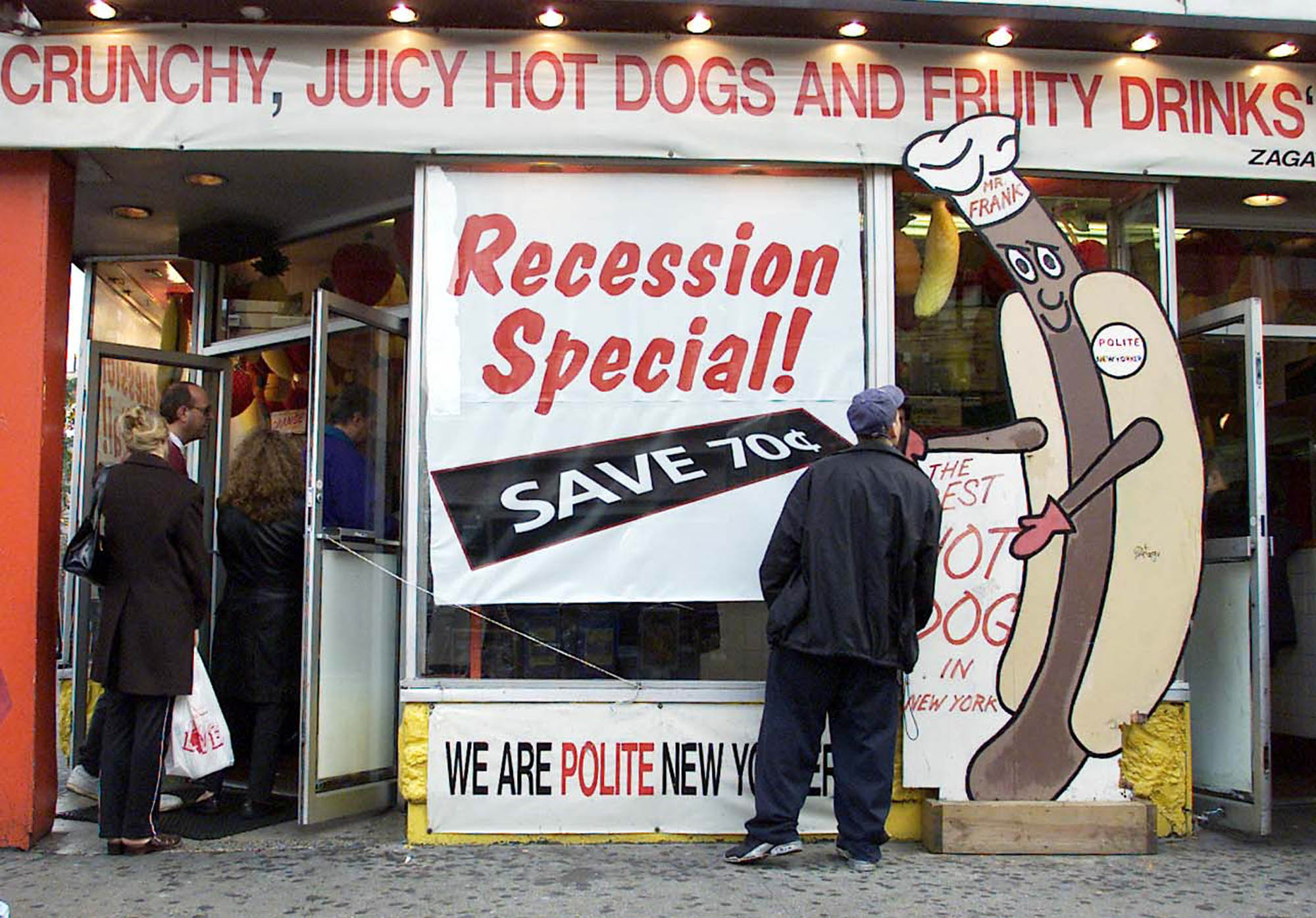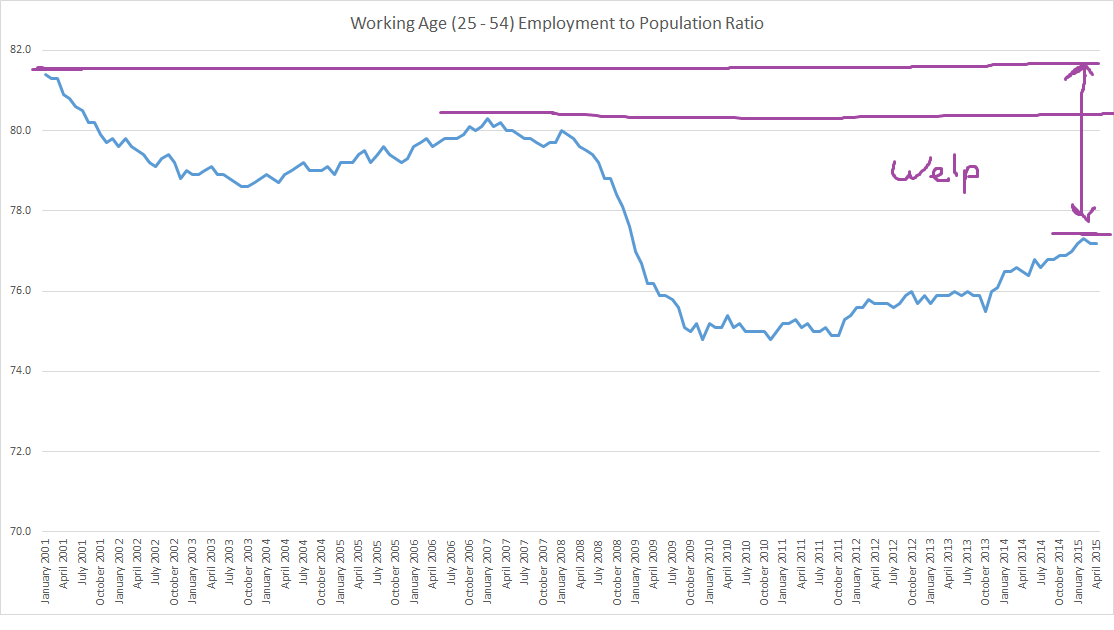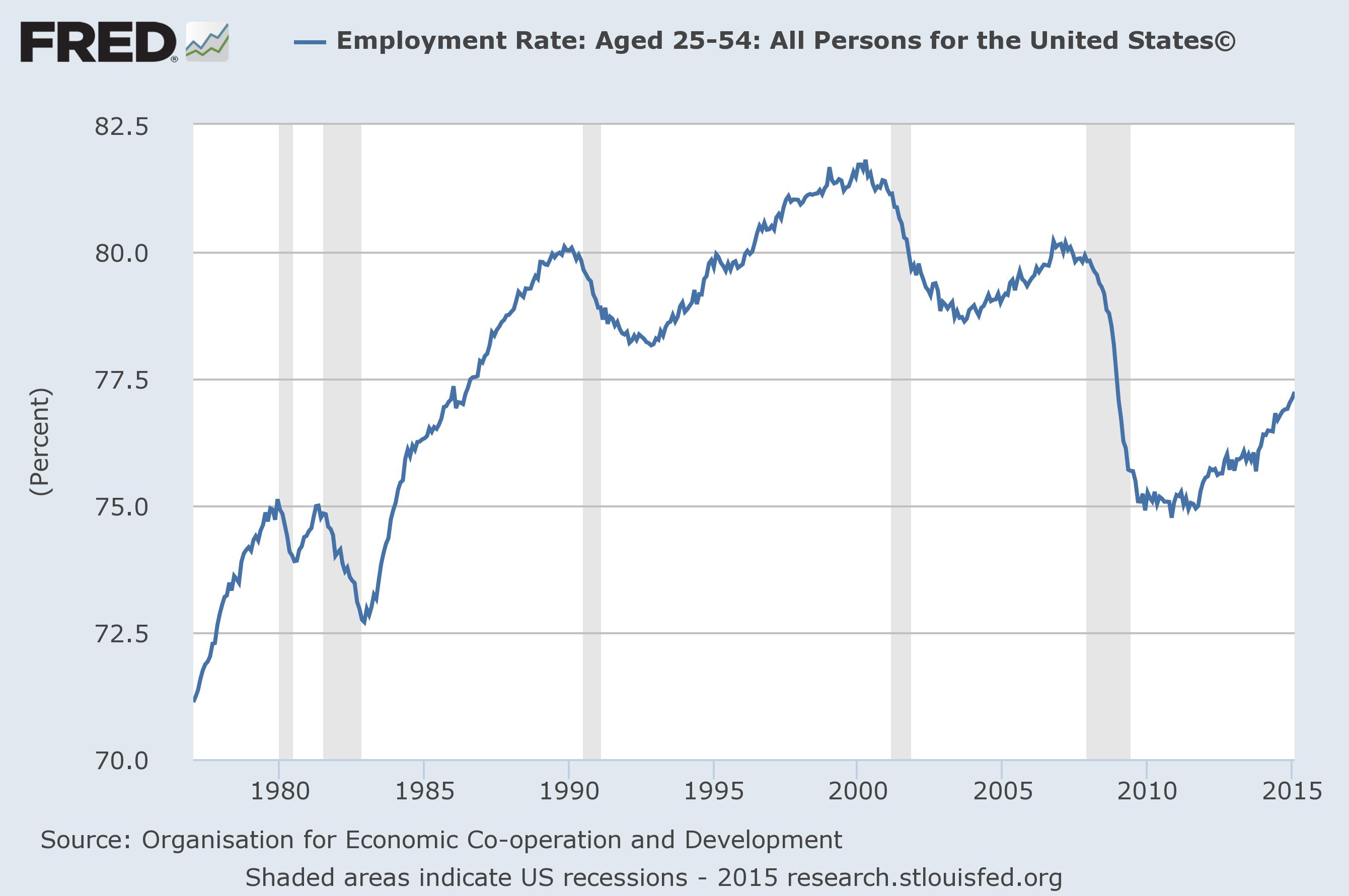The 2001 recession never really ended
We've spent the last 14 years trying to dig out of the same hole...


The latest jobs report seemed like welcome news: 223,000 jobs were added in April, compared to March's anemic 85,000. And the unemployment rate fell another notch, from 5.5 percent to 5.4 percent.
But beneath the surface, things are not so good. Wage growth is still flat, meaning employers are feeling no pressure to pay people more. They're able to attract more people to take work without offering higher compensation, which can only be happening if a lot of people out there have simply given up on work entirely. Wages won't start rising until we get all of these people back into the labor force.
Remember, the unemployment rate is the ratio of employed people to people who are actively looking for work — i.e., in the labor force. The jobless rate doesn't account for people who have given up looking entirely. A better metric of the economy's true health is the employment-to-population ratio, where population is everyone in the country 16 years and over who isn't in the army or in prison or in a mental ward. Reporters don't look at this number as much, but it's also buried in each monthly jobs report. For April, it stood at 59.3 percent.
The Week
Escape your echo chamber. Get the facts behind the news, plus analysis from multiple perspectives.

Sign up for The Week's Free Newsletters
From our morning news briefing to a weekly Good News Newsletter, get the best of The Week delivered directly to your inbox.
From our morning news briefing to a weekly Good News Newsletter, get the best of The Week delivered directly to your inbox.
It was just over 63 percent in 2007. Then it got clobbered by the 2008 collapse. It has yet to come anywhere close to recovering.
But it gets worse. To really drill down, we need to look at the employment-to-population ratio for people in the their prime working years. Too young, and you're including a lot of people who aren't working simply because they're still getting an education. Too old, and you get people who aren't working because they've quite rightly retired. Looking at the population of people age 25 to 54 is a good sweet spot.
That metric fell from 80 percent in 2007 to 75 percent at the deepest part of the slump. Several years later, it's only recovered to about 77 percent. And here's the most disturbing part: That 80 percent in 2007 was still below where it had been before the 2001 recession.
Nick Bunker, a policy analyst at the Washington Center for Equitable Growth, and a go-to source for Twitter reaction to the jobs reports (and most anything else in the economic world) had the goods — along with some aptly grim personal notation — on Friday:
A free daily email with the biggest news stories of the day – and the best features from TheWeek.com

(Nick Bunker, policy analyst at the Washington Center for Equitable Growth)
Americans hadn't even gotten back the employment they lost way back in 2001 when the 2008 collapse hit.
Still, the long-term trend here is a little hard to tease out. Between the 1960s and the 1980s, the baseline level of employment underwent a massive one-time surge thanks to the entrance of more and more women into the labor force. The percentage of all men in the 25-54 age range who are employed has been on a slow descent since the 1950s, while women peaked in the 2000s and only just recently started falling. (Though at 83.6 percent now, men still outperform women, who never got above 75 percent and are currently at 70.2 percent.) Still, put it all together, and the last 15 years look lousy, despite the small uptick of the last few years.

This is bad because of what economists call hysteresis. When people are out of work for extended periods — which is what's happening in this country — they lose skills, and their social and professional networks deteriorate. People who are unemployed can't spend money, and communities where people can't spend money lose businesses, so more people lose their jobs, and a whole local geography of unemployment and poverty sets in.
The country's safety net is too skimpy to actually fix this problem — probably the most under-appreciated aspect of a generously redistributive welfare engine is the way it pumps demand back into stricken areas, thus allowing businesses and jobs to recover. But sometimes, it can be just enough to allow people to eke out a meager existence.
Meanwhile, more families will break up under financial stress. The children of the families that have been squeezed out of the economy will have a tougher time getting a good education, and may well be left with permanent scars, both in terms of their psychological well-being and their physical health. So the longer this downward ratchet in the employment ratio goes on, the more lives will be wrecked, and the more likely it is that the American economy as a whole will be permanently injured and left poorer.
With the last three recessions the U.S. has been through — 1990, 2001, and 2008 — employment recovered at a much slower pace than it did in 1983 or any recession before then. So sometime after that 1983 slump, the economy went through a fundamental shift.
Before then, the economy spent a healthy amount of the time at full employment. Everyone who wanted work had a relatively easy time getting it, so businesses had to keep hiking pay to attract employees. But since then, the only time in the last 30+ years that the economy was briefly at full employment was in the late 1990s, when wages at all income levels briefly rose. That was also when the 25-54 employment-population ratio hit a peak of 81.8 percent, to which it's never returned.
We now seem to have reached the point where we're stuck in a big hole, and before we can climb out of it, a new slump comes and digs the hole deeper.
If that doesn't scare you, consider this: Recent recessions have tended to hit once every ten years or so. And the last one was 2008 — seven years ago.
Jeff Spross was the economics and business correspondent at TheWeek.com. He was previously a reporter at ThinkProgress.
-
 7 bars with comforting cocktails and great hospitality
7 bars with comforting cocktails and great hospitalitythe week recommends Winter is a fine time for going out and drinking up
-
 7 recipes that meet you wherever you are during winter
7 recipes that meet you wherever you are during winterthe week recommends Low-key January and decadent holiday eating are all accounted for
-
 Nine best TV shows of the year
Nine best TV shows of the yearThe Week Recommends From Adolescence to Amandaland
